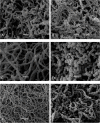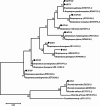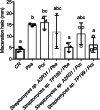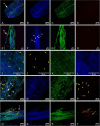Antagonistic activity of endophytic actinobacteria from native potatoes (Solanum tuberosum subsp. tuberosum L.) against Pectobacterium carotovorum subsp. carotovorum and Pectobacterium atrosepticum
- PMID: 34876006
- PMCID: PMC8650274
- DOI: 10.1186/s12866-021-02393-x
Antagonistic activity of endophytic actinobacteria from native potatoes (Solanum tuberosum subsp. tuberosum L.) against Pectobacterium carotovorum subsp. carotovorum and Pectobacterium atrosepticum
Abstract
Background: The native potatoes (Solanum tuberosum subsp. tuberosum L.) grown in Chile (Chiloé) represent a new, unexplored source of endophytes to find potential biological control agents for the prevention of bacterial diseases, like blackleg and soft rot, in potato crops.
Result: The objective of this study was the selection of endophytic actinobacteria from native potatoes for antagonistic activity against Pectobacterium carotovorum subsp. carotovorum and Pectobacterium atrosepticum, and their potential to suppress tissue maceration symptoms in potato tubers. This potential was determined through the quorum quenching activity using a Chromobacterium violaceaum ATCC 12472 Wild type (WT) bioassay and its colonization behavior of the potato plant root system (S. tuberosum) by means of the Double labeling of oligonucleotide probes for fluorescence in situ hybridization (DOPE-FISH) targeting technique. The results showed that although Streptomyces sp. TP199 and Streptomyces sp. A2R31 were able to inhibit the growth of the pathogens, only the Streptomyces sp. TP199 isolate inhibited Pectobacterium sp. growth and diminished tissue maceration in tubers (p ≤ 0.05). Streptomyces sp. TP199 had metal-dependent acyl homoserine lactones (AHL) quorum quenching activity in vitro and was able to colonize the root endosphere 10 days after inoculation.
Conclusions: We concluded that native potatoes from southern Chile possess endophyte actinobacteria that are potential agents for the disease management of soft rot and blackleg.
Keywords: Blackleg; Confocal laser microscopy; Endophytic actinobacteria; Potato; Quorum quenching; Soft rot; Streptomyces sp..
© 2021. The Author(s).
Conflict of interest statement
The authors declare no conflict of interest. The funders had no role in the design of the study; in the collection, analyses, or interpretation of data; in the writing of the manuscript, or in the decision to publish the results.
Figures







Similar articles
-
Control of potato soft rot caused by Pectobacterium carotovorum and Pectobacterium atrosepticum by Moroccan actinobacteria isolates.World J Microbiol Biotechnol. 2012 Jan;28(1):303-11. doi: 10.1007/s11274-011-0820-5. Epub 2011 Jun 23. World J Microbiol Biotechnol. 2012. PMID: 22806806
-
Bacteriophages Isolated in China for the Control of Pectobacterium carotovorum Causing Potato Soft Rot in Kenya.Virol Sin. 2019 Jun;34(3):287-294. doi: 10.1007/s12250-019-00091-7. Epub 2019 Mar 13. Virol Sin. 2019. PMID: 30868359 Free PMC article.
-
Quorum quenching strategies of endophytic Bacillus thuringiensis KMCL07 against soft rot pathogen Pectobacterium carotovorum subsp. carotovorum.Microb Pathog. 2025 Mar;200:107356. doi: 10.1016/j.micpath.2025.107356. Epub 2025 Feb 5. Microb Pathog. 2025. PMID: 39921045
-
The Changing Face of Bacterial Soft-Rot Diseases.Annu Rev Phytopathol. 2018 Aug 25;56:269-288. doi: 10.1146/annurev-phyto-080417-045906. Epub 2018 Jun 29. Annu Rev Phytopathol. 2018. PMID: 29958075 Review.
-
Looking for Resistance to Soft Rot Disease of Potatoes Facing Environmental Hypoxia.Int J Mol Sci. 2024 Mar 28;25(7):3757. doi: 10.3390/ijms25073757. Int J Mol Sci. 2024. PMID: 38612570 Free PMC article. Review.
Cited by
-
Potato Microbiome: Relationship with Environmental Factors and Approaches for Microbiome Modulation.Int J Mol Sci. 2024 Jan 6;25(2):750. doi: 10.3390/ijms25020750. Int J Mol Sci. 2024. PMID: 38255824 Free PMC article. Review.
-
Actinobacteria as Effective Biocontrol Agents against Plant Pathogens, an Overview on Their Role in Eliciting Plant Defense.Microorganisms. 2022 Aug 29;10(9):1739. doi: 10.3390/microorganisms10091739. Microorganisms. 2022. PMID: 36144341 Free PMC article. Review.
-
Exploring the potential of endophyte-plant interactions for improving crop sustainable yields in a changing climate.Front Plant Sci. 2024 Mar 20;15:1349401. doi: 10.3389/fpls.2024.1349401. eCollection 2024. Front Plant Sci. 2024. PMID: 38571718 Free PMC article. Review.
References
-
- FAO. Food and Agriculture Organization of the United Nations . Faostat statistical database, Potatoes Crop Production, and Yield. Rome: FAO; 2020.
-
- Pérombelon M. Potato diseases caused by soft rot erwinias: an overview of pathogenesis. Plant Pathol J. 2002;51(1):1–12. doi: 10.1046/j.0032-0862.2001.Shorttitle.doc.x. - DOI
-
- Vreugdenhil D, Bradshaw J, Gebhardt C, Govers F, Taylor MA, MacKerron DK, et al. Potato biology and biotechnology: advances and perspectives. Wageningen: Elsevier; 2011.
-
- Mantsebo CC, Mazarura U, Goss M, Ngadze E. The epidemiology of Pectobacterium and Dickeya species and the role of calcium in postharvest soft rot infection of potato (Solanum tuberosum) caused by the pathogens: a review. Afr J Agric Res. 2014;9(19):1509–1515. doi: 10.5897/AJAR2013.8558. - DOI
Publication types
MeSH terms
Substances
Supplementary concepts
LinkOut - more resources
Full Text Sources
Molecular Biology Databases

